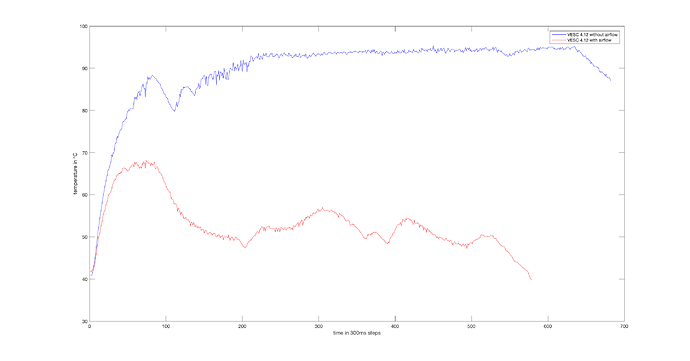I have done a comparison how airflow is affecting the temperature rise of the VESC 4.12 hardware. You can watch the video here:
I know that this forum is mainly for electric skateboard stuff, but because my electric skateboard wasn’t powerful enough to stress the VESC 4.12 as much as needed I think using a eBike does’t make it less interesting for you guys. 
To give you an more detailed insight of my setup: The VESC itself is self soldered with a self build heatsink on top of the MOSFETs. I was aware, that the heat transfer between the D2Pak plastic housing and the aluminum heatsink wouldn’t be great but I did it anyways and also put thermal paste between them. The settings were at 50A max battery current and 120A max motor current. The MOSFET temperature limit start was set to 80°C and the end to 100°C.
I was running the test on my eBike with a MXUS 3000 v3 motor and 10000mAh Multistar 11s battery. I compared the temperatures when the VESC was inside my bike bag (so no airflow at all) and with the VESC + heatsink was hanging out of the bag.
I was logging all the VESC data with the bluetooth module from https://metr.at and the metr.at iOS app. The app is also available for Android and there is also the perimetr app available to change the VESC settings on the fly. You can find more infos in this thread .
Here you can see my logs from the metr.at logging app:
(short run on hill with a big incline without air-cooling)
(short run on hill with a big incline with air-cooling)
(longer run on hill with a smaller incline without air-cooling)
(longer run on hill with a smaller incline with air-cooling)
This data was then overlaid to the video that I have done with my Xiaomi Yi and a StorM32 BGC brushless gimbal. The elevation data isn’t that accurate because of a missing barometer in my phone. You can also see that I had to release the full throttle sometimes and brake with the bikes disc brakes. (no regen braking activated right now)
I have also created two graphs of the two runs where you can see the different temperature rise better.
As you can see without air cooling I was hitting the temperature limit at the end.
You can see in that graph how the temperature of the uncooled VESC stays in the “temperature limit zone”. Because of that limit I reached the same location a lot later, while the cooled one stays under 70°C the whole time.
So lets summarize what I have learned from the test. It is very important to use the airflow when it is possible for you to mount the VESC where the air is flowing. When mounted correctly the VESC 4.12 hardware is able to take a lot of current without getting to hot. I was aware that the airflow has a big influence to the temperature development, but not as big as seen in the graphs. Impressive. A lot of builds of electric skateboards I have seen dont use the airflow from driving at all. When not hitting the temperature limit thats ok, but if you need more power you know what to do.
Ps.: This is a repost from builders forum from May 2017. With all those aluminium VESC enclosures that hit the market after that post I think it is even more relevant today. With these aluminium VESC cases it is a lot easier to use the available airflow by having the fins outside the board enclosure.


 Glad you like it.
Glad you like it.